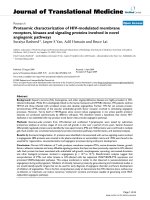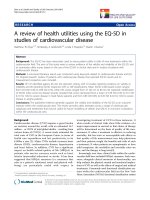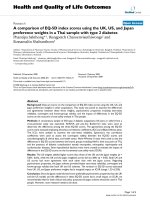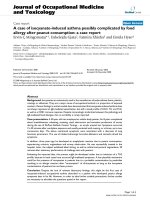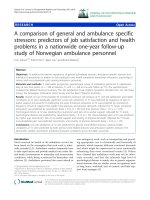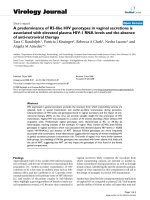Báo cáo hóa học: "A CHARACTERIZATION OF CHAOTIC ORDER" pdf
Bạn đang xem bản rút gọn của tài liệu. Xem và tải ngay bản đầy đủ của tài liệu tại đây (467.86 KB, 6 trang )
A CHARACTERIZATION OF CHAOTIC ORDER
CHANGSEN YANG AND FUGEN GAO
Received 15 November 2005; Accepted 4 January 2006
The chaotic order A
B among positive invertible operators A,B>0onaHilbertspace
is introduced by logA
≥ logB. Using Uchiyama’s method and Furuta’s Kantorovich-type
inequality, we will point out that A
B if and only if B
p
A
−p/2
B
−p/2
A
p
≥ B
p
holds
for any 0 <p<p
0
,wherep
0
is any fixed positive number. On the other hand, for any
fixed p
0
> 0, we also show that there exist positive invertible operators A, B such that
B
p
A
−p/2
B
−p/2
A
p
≥ B
p
holds for any p ≥ p
0
,butA B is not valid.
Copyright © 2006 C. Yang and F. Gao. This is an open access article distributed under
the Creative Commons Attribution License, which permits unrestricted use, distribution,
and reproduction in any medium, provided the original work is properly cited.
1. Introduction
In what follows, a capital letter means a bounded linear operator on a complex Hilbert
space H.AnoperatorT is said to be positive, in symbol T
≥ 0if(Tx,x) ≥ 0forallx ∈ H.
In particular, we denote by A>0ifA
≥ 0 is invertible. By the operator monotonicity of
the logarithmic function, we know that A
≥ B>0 implies the chaotic order A B.For
the chaotic order, several char acterizations were shown by many authors, for example,
[1–3, 6]. The following well-known results about chaotic order were obtained.
Theorem 1.1 [1, 2]. Let A and B be positive invertible operators. Then the following prop-
ert ies are mutually equivalent:
(i) logA
≥ log B;
(ii) (B
p/2
A
p
B
p/2
)
1/2
≥ B
p
for all p ≥ 0;
(iii) (B
r/2
A
p
B
r/2
)
r/(p+r)
≥ B
r
for all p ≥ 0 and r ≥ 0.
Theorem 1.2 Kantorovich type inequalities [3]. Let A>0 and for positive numbers M, m,
M
≥ B ≥ m>0. Then the following parallel statements hold. Moreover, (ii) can be derived
from (i).
Hindawi Publishing Corporation
Journal of Inequalities and Applications
Volume 2006, Article I D 79123, Pages 1–6
DOI 10.1155/JIA/2006/79123
2 A characterization of chaotic order
(i) A
≥ B implies ((M
p−1
+ m
p−1
)
2
/(4m
p−1
M
p−1
))A
p
≥ B
p
for all p ≥ 2.
(ii) logA
≥ log B implies ((M
p
+ m
p
)
2
/(4m
p
M
p
))A
p
≥ B
p
for all p ≥ 0.
Theorem 1.3 [6]. Let A and B be posit ive invertible operators. Then A
≥ B>0 if and only
if
B
p−1
A
−(p−2)/2
B
−p/2
A
p−1
≥ B
p−1
for all p ≥ 2.
As a parallel statement of Theorem 1.3, we point out the following result on the chaotic
orderoftwopositiveinvertibleoperators.
Theorem 1.4. Let A and B be positive invertible operators. Then for a fixed p
0
> 0,the
following a ssertions are mutually equivalent:
(i) A
B;
(ii)
B
p
A
−p/2
B
−p/2
A
p
≥ B
p
holds for all p>0;
(iii)
B
p
A
−p/2
B
−p/2
A
p
≥ B
p
holds for any p ∈ (0, p
0
).
On the other hand, we will prove that the condition p
∈ (0, p
0
)inTheorem 1.4 is
essential as follows.
Theorem 1.5. For a fixed p
0
> 0, there exist positive invertible operators A, B such that
B
p
A
−p/2
B
−p/2
A
p
≥ B
p
holds for any p ≥ p
0
,butA B is not valid.
2. The proofs of the main results
To give a proof of Theorem 1.4, we also need the following well-known theorem used in
[3] which is essentially the same as [5].
Theorem 2.1 [3, 5]. Let X>0, then lim
n→∞
(I +logX/n)
n
= X.
Proof of Theorem 1.4. (i)
⇒(ii) Suppose that logA ≥logB.Letp>0, then for sufficiently
large n,wehaveI +logA/n
≥ I +logB/n > 0andnp ≥ 2. Put A
1
= I +logA/n and B
1
=
I +logB/n.ThenwehaveA
1
≥ B
1
> 0 and applying Theorem 1.3, the following inequality
holds:
B
n(p−1/n)
1
A
n(−(p−2/n)/2)
1
B
n(−p/2)
1
A
n(p−1/n)
1
≥ B
n(p−1/n)
1
(2.1)
for all np
≥ 2. By Theorem 2.1,wehaveA
n
1
→ A and B
n
1
→ B as n →∞.Henceletn →∞
in (2.1), then we obtain B
p
A
−p/2
B
−p/2
A
p
≥ B
p
holds for all p>0;
(ii)
⇒(iii) Obvious.
(iii)
⇒(i) Let 0 <p<p
0
and λ
p
=B
p
A
−p/2
B
−p/2
.ThenB
p
≤ λ
p
A
p
by (iii). By L-H the-
orem, we also have B
p/2
≤ λ
1/2
p
A
p/2
,thusB
3p/2
≤ λ
1/2
p
B
p/2
A
p/2
B
p/2
.Nowsupposethat0<
m
≤ B ≤ M.So0<m
3p/2
≤ B
3p/2
≤ M
3p/2
. Applying (i) of Theorem 1.2,weobtain
B
3p
≤
M
3p/2
+ m
3p/2
2
4M
3p/2
m
3p/2
λ
p
B
p/2
A
p/2
B
p/2
2
. (2.2)
C. Yang and F. Gao 3
Hence
B
2p
≤
M
3p/2
+ m
3p/2
2
4M
3p/2
m
3p/2
λ
p
A
p/2
B
p
A
p/2
. (2.3)
By (2.3)andλ
p
=B
−p/2
A
−p/2
B
2p
A
−p/2
B
−p/2
1/2
,wehave
λ
2
p
≤
M
3p/2
+ m
3p/2
2
4M
3p/2
m
3p/2
λ
p
. (2.4)
So
λ
p
≤
M
3p/2
+ m
3p/2
2
4M
3p/2
m
3p/2
. (2.5)
Therefore
B
p
≤
M
3p/2
+ m
3p/2
2
4M
3p/2
m
3p/2
A
p
. (2.6)
By (2.6), we also have
logB
≤
1
p
log
M
3p/2
+ m
3p/2
2
4M
3p/2
m
3p/2
+logA. (2.7)
Let p
→ 0, we obtain (i).
To prove Theorem 1.5, we first cite the following simple inequalities.
Lemma 2.2. Let a, b, d be three positive numbers, then
(i) b
≤
ab
bd
,
(ii)
ab
bd
≤
(a + b + d)I.
Proof of Theorem 1.5. Suppose p
0
> 0. Let A =
9/5 −2/5
−2/56/5
,andB =
20
0 ε
,whereε ∈(0,(1/
2)[(2
−2
1−p
0
/2
)
2
/(7 +3 ·2
−p
0
)
4
]
1/p
0
).
Note that A
= U
∗
20
01
U,whereU =(1/
√
5)
−21
12
is a unitary operator, by a simple
computation, we have
B
−p/2
A
−p/2
B
2p
A
−p/2
B
−p/2
=
1
25
⎛
⎜
⎜
⎜
⎜
⎜
⎜
⎜
⎜
⎜
⎜
⎜
⎜
⎜
⎜
⎝
1+2
2−p/2
2
2
p
+2
−p
ε
2p
2−2
1−p/2
2
2 −2
1−p/2
2
3p/2
1+2
2−p/2
ε
p/2
+
ε
3p/2
4+2
−p/2
2
p/2
2 −2
1−p/2
2
3p/2
1+2
2−p/2
ε
p/2
2
2p
ε
−p
2−2
1−p/2
2
+ ε
p
4+2
−p/2
2
+
ε
3p/2
4+2
−p/2
2
p/2
⎞
⎟
⎟
⎟
⎟
⎟
⎟
⎟
⎟
⎟
⎟
⎟
⎟
⎟
⎟
⎠
.
(2.8)
4 A characterization of chaotic order
Applying (i) of Lemma 2.2,weobtain
B
−p/2
A
−p/2
B
2p
A
−p/2
B
−p/2
1/2
≥
1
5
2 −2
1−p/2
2
3p/2
1+2
2−p/2
ε
p/2
+
ε
3p/2
4+2
−p/2
2
p/2
1/2
≥
ε
−p/4
2
3p/4
2 −2
1−p/2
1/2
5
≥
ε
−p/4
2
3p/4
2 −2
1−p
0
/2
1/2
5
.
(2.9)
On the other hand, we can compute that
A
−p/2
B
p
A
−p/2
=
1
25
⎛
⎜
⎜
⎜
⎜
⎜
⎜
⎜
⎜
⎝
2
p
1+4·2
−p/2
2
+4ε
p
1 −2
−p/2
2
1 −2
−p/2
2
p+1
1+4·2
−p/2
+2ε
p
4+2
−p/2
1 −2
−p/2
2
p+1
1+4·2
−p/2
+2ε
p
4+2
−p/2
4 ·2
p
1 −2
−p/2
2
+ ε
p
4+2
−p/2
2
⎞
⎟
⎟
⎟
⎟
⎟
⎟
⎟
⎟
⎠
.
(2.10)
Hence by Lemma 2.2 (ii), we have
A
−p/2
B
p
A
−p/2
≤
1
25
2
p
1+4·2
−p/2
2
+4ε
p
1 −2
−p/2
2
+
1 −2
−p/2
2
p+1
1+4·2
−p/2
+2ε
p
4+2
−p/2
+4·2
p
1 −2
−p/2
2
+ ε
p
4+2
−p/2
2
=
2
p
25
7+6·2
−p/2
+12·2
−p
+
ε
p
25
28 −6 ·2
−p/2
+3·2
−p
≤
2
p
25
35 + 15 ·2
−p
≤
2
p
5
7+3·2
−p
0
.
(2.11)
Because 0 < (2ε)
p
0
/4
< (2 −2
1−p
0
/2
)
1/2
/(7 +3 ·2
−p
0
) < 1, so for p>p
0
,
(2ε)
p/4
<
2 −2
1−p
0
/2
1/2
7+3·2
−p
0
< 1. (2.12)
Therefore by (2.9), (2.11), and (2.12), we have
B
−p/2
A
−p/2
B
2p
A
−p/2
B
−p/2
1/2
≥
ε
−p/4
2
3p/4
2 −2
1−p
0
/2
1/2
5
≥
2
p
5
7+3·2
−p
0
≥
A
−p/2
B
p
A
−p/2
.
(2.13)
C. Yang and F. Gao 5
To complete the proof of Theorem 1.5, we only prove that (AB
2
A)
1/2
≤ A
2
for very
small ε>0byTheorem 1.1. But by a simple computation, this is equivalent to prove
⎛
⎜
⎝
B
1
B
3
B
3
B
2
⎞
⎟
⎠
≡
⎛
⎜
⎝
324 + 4ε
2
−72 −12ε
2
−72 −12ε
2
16 + 36ε
2
⎞
⎟
⎠
1/2
≤
⎛
⎜
⎝
17 −6
−68
⎞
⎟
⎠
. (2.14)
Let A
1
= 324 + 4ε
2
, A
2
= 16 + 36ε
2
,andA
3
=−72 −12ε
2
.By[4], if
V
=
1
A
1
−A
2
+2ε
1
⎛
⎜
⎝
A
1
−A
2
+ ε
1
−
√
ε
1
−
√
ε
1
−
A
1
−A
2
+ ε
1
⎞
⎟
⎠
, (2.15)
where
2ε
1
=−A
1
+ A
2
+
A
1
−A
2
2
+4A
2
3
. (2.16)
Then
⎛
⎜
⎝
B
1
B
3
B
3
B
2
⎞
⎟
⎠
=
V
⎛
⎜
⎝
A
1
+ ε
1
0
0
A
2
−ε
1
⎞
⎟
⎠
V. (2.17)
Hence
B
1
=
A
1
−A
2
+ ε
1
A
1
+ ε
1
+ ε
1
A
2
−ε
1
A
1
−A
2
+2ε
1
. (2.18)
When ε is very small, we have
2ε
1
=−308 + 32ε
2
+
115600 −12800ε
2
+ o
ε
2
=
32 +
224
17
ε
2
+ o
ε
2
;
ε
1
= 16 +
112
17
ε
2
+ o
ε
2
;
A
1
+ ε
1
=
√
340 + o(ε);
A
1
−A
2
+2ε
1
= 340 + o(ε); ε
1
A
2
−ε
1
= o(1).
(2.19)
Hence by (2.18), we have B
1
= 324/
√
340 + o(1). Because 324/
√
340 > 17, so (2.14)isvalid
for some small ε>0.
Therefore the proof of Theorem 1.5 is complete.
The following corollary can be der ived from Theorem 1.4.
Corollary 2.3. Let T be an invertible operator. Then T is a log-hyponormal operator if
and only if
T
∗
2p
|T|
−p
T
∗
−p
|
T|
2p
≥
T
∗
2p
(2.20)
holds for any small p>0.
6 A characterization of chaotic order
References
[1] T. Ando, On some operator inequalities, Mathematische Annalen 279 (1987), no. 1, 157–159.
[2] M. Fujii, T. Furuta, and E. Kamei, Furuta’s inequality and its application to Ando’s theorem, Linear
Algebra and Its Applications 179 (1993), 161–169.
[3] T. Furuta, Results under logA
≥ log B can be derived from ones under A ≥ B ≥ 0 by Uchiyama’s
method—associated with Furuta and Kantorovich type operator inequalities, Mathematical In-
equalities & Applications 3 (2000), no. 3, 423–436.
[4] K. Tanahashi, Best possibility of the Furuta inequality, Proceedings of the American Mathematical
Society 124 (1996), no. 1, 141–146.
[5] M. Uchiyama, Some exponential operator inequalities, Mathematical Inequalities & Applications
2 (1999), no. 3, 469–471.
[6] T. Yamazaki, Characterizations of logA
≥ logB and normaloid operators via Heinz inequality,In-
tegral Equations and Operator Theory 43 (2002), no. 2, 237–247.
Changsen Yang: Department of Mathematics, Henan Normal University, Xinxiang,
Henan 453007, China
E-mail address:
Fugen Gao: Department of Mathematics, Henan Normal University, Xinxiang, Henan 453007, China
E-mail address:

